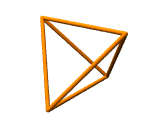
Some Angles and Perspectives

|
|
||
 |
Some Angles and Perspectives |
 |
|
|
||
| Item | Excerpt |
|
Synergetics: Explorations in the Geometry of Thinking by R. Buckminster Fuller |
Although originally published by Macmillan in
two separate volumes (in 1975 and 1979 respectively), it was always
the author's intention that the numbered passages in each would
someday be shuffled into a single "deck". This happened -- in the
web edition of this magnum opus.
|
|
Synergetics by E.J. Applewhite |
Synergetics is Fuller's name for the geometry he
advanced based on the patterns of energy that he saw in
nature.
For him, geometry was a laboratory science with the touch and feel of physical models--not rules out of a textbook. He started with models of the closest packing of spheres. From that basic starting point he derived triangles as the most economical relationship between events. |
| A Fuller
Explanation by Dr. Amy C. Edmondson |
The goal of this book is to catalyze a process
which I hope will continue and expand on its own: to rescue
Fuller's fascinating material from its unfortunate
obscurity.
|
| Reading
Synergetics: Some Tips by Chris Fearnley |
Synergetics is systemic. Often we try to get a
one frame-view of Universe. But in synergetics we have many
interacting systems. We must change our angular perspective to find
the relationship that we are interested in. Often in synergetics
some interesting system will only be partially and tantalizingly
explored by Fuller in the text. So you begin to ask some of your
own questions. Now is the time to begin an investigation - to try
your hand at cosmic fishing.
|
| An Introduction to
Synergetics by Kirby Urner |
Synergetics is a 'geometry of lumps' in which
even points occupy volume, however infinitesimal. All objects in
synergetic topology have the same dimensional characteristics. Nor
are 'perfect solids' ever defined. Every surface is
permeable.
|
|
The Invention Behind the Inventions: Synergetics in the 1990s by Kirby Urner |
R. Buckminster Fuller was best known for his
geodesic domes. This fact has both helped and hampered our efforts
to draw attention to his synergetic geometry, the "invention behind
the inventions." Scientists will typically make the link between
the shape of a virus or carbon molecule, and the dome's distinctive
architecture, but then stop short of exploring the underlying
tetrahedral geometry, because "architecture" is not virology or
chemistry, and because "synergetics" is not in their
vocabulary.
|
| Memo to the National Council of Mathematics Teachers by K. Urner |
In just three paragraphs I've covered a lot of geometry, and it wasn't hard to grasp -- none of it was beyond a 10th grader's level of literacy. With a few high powered animations and some hands-on model making, kids would have all this stowed away in no time. With this basic toolkit absorbed, it's easier to navigate in the structured worlds of virology, chemistry, crystallography, even cartography. A lot more of the curriculum finds a foothold, once the concentric hierarchy is firmly anchored. The chemistry teacher down the hall will have a much easier time discussing the allotropes of carbon with students already so well prepared. |
| Toward a Psychology of Synergetics by Kirby Urner |
The link to 'Synergetics' is clear too: Fuller
launches various signifiers into a namespace of his own invention.
Just because we have a sense of 'gravity' from reading in some
Newtonian field, doesn't necessarily give us the whole story with
regard to these alternative (i.e. remote, alien) usages, wherein
'precession' and 'radiation' are likewise participating in the void
('isotropic vector matrix'), in a way that is mutually
co-definitional.
|
| Beyond
Flatland: Geometry for the 21st Century by Kirby Urner |
Given the streamlining effects of merging fcc
packing with the octet truss and a concentric hierarchy of
easy-to-remember volumes, the essentials of this curriculum are
likely to gravitate down to lower grade levels, such that all of
the above will be in some form accessible to an average 14 year
old. Using TV, the internet, and film, it should be possible to
communicate this primary level information quickly to a fairly
large and global audience. We hope to have this job completed or
well underway by the end of 1998.
|
| Archives of Synergetics-L | Five years worth of archived content downloadable as compressed text file. Many people from different walks of life talking about synergetics and related topics, and contributing the results of their own research. |
|
Synergetics on the
Web |
|